Comprehensive Care Plan for Diabetes & Hypertension Patient
VerifiedAdded on 2023/06/12
|5
|1483
|309
Case Study
AI Summary
This case study presents a care plan for Louca, a 69-year-old patient with Type 2 Diabetes and hypertension, complicated by a high BMI. The analysis identifies hypotension and potential wound infection as primary nursing concerns. The care plan outlines SMART goals focusing on managing Louca's condition through monitoring, medication, and infection prevention. Specific actions include ECG monitoring, fluid management, wound care with antiseptics, and electrolyte balance assessment. The plan emphasizes evaluating outcomes through stabilized blood pressure, reduced infection risk, and controlled dizziness. The solution also addresses potential complications from unstable blood glucose levels, including hypoglycemia, and suggests interventions for pain management and patient comfort. This assignment is available on Desklib, along with a wealth of study resources for students.
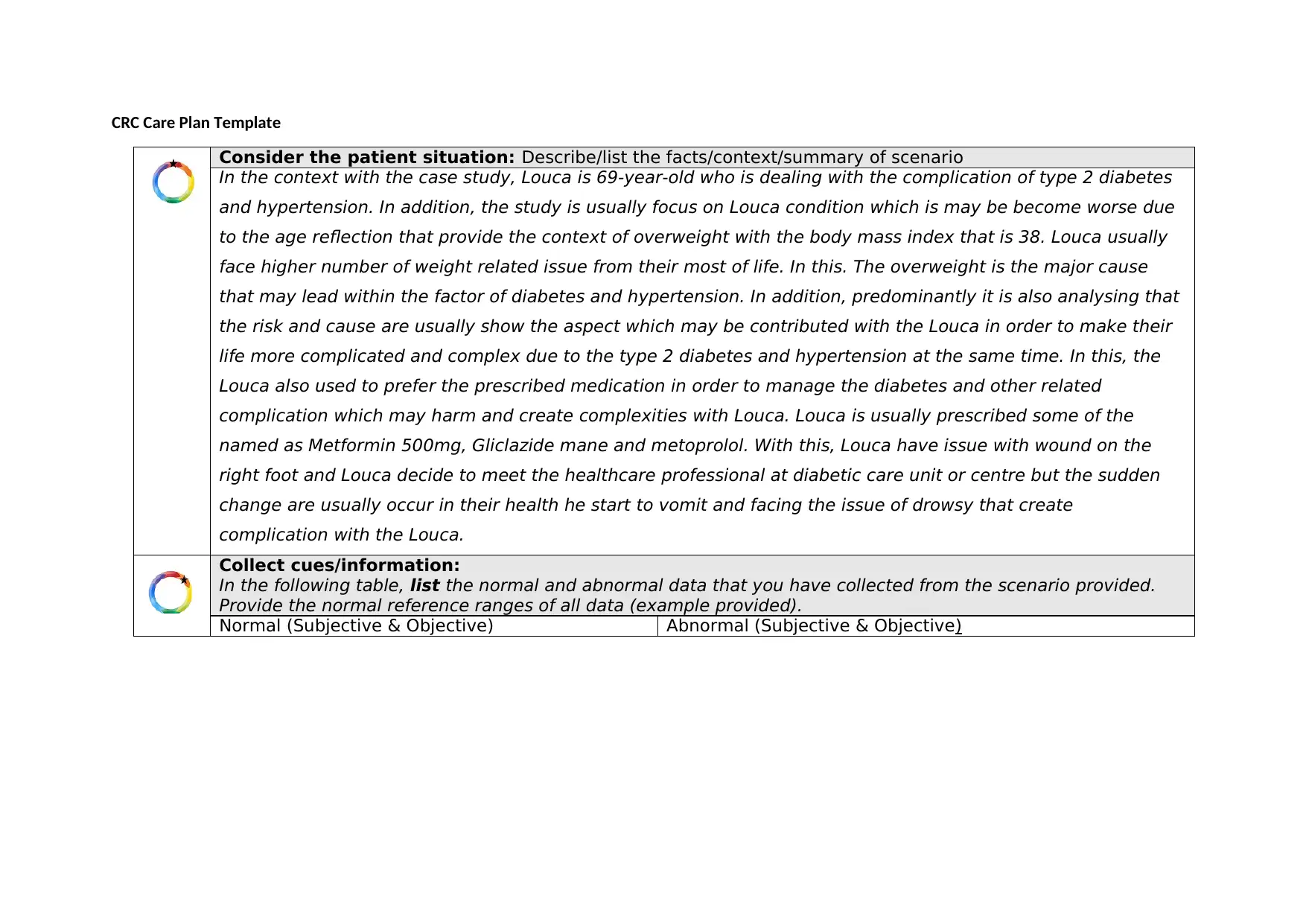
CRC Care Plan Template
Consider the patient situation: Describe/list the facts/context/summary of scenario
In the context with the case study, Louca is 69-year-old who is dealing with the complication of type 2 diabetes
and hypertension. In addition, the study is usually focus on Louca condition which is may be become worse due
to the age reflection that provide the context of overweight with the body mass index that is 38. Louca usually
face higher number of weight related issue from their most of life. In this. The overweight is the major cause
that may lead within the factor of diabetes and hypertension. In addition, predominantly it is also analysing that
the risk and cause are usually show the aspect which may be contributed with the Louca in order to make their
life more complicated and complex due to the type 2 diabetes and hypertension at the same time. In this, the
Louca also used to prefer the prescribed medication in order to manage the diabetes and other related
complication which may harm and create complexities with Louca. Louca is usually prescribed some of the
named as Metformin 500mg, Gliclazide mane and metoprolol. With this, Louca have issue with wound on the
right foot and Louca decide to meet the healthcare professional at diabetic care unit or centre but the sudden
change are usually occur in their health he start to vomit and facing the issue of drowsy that create
complication with the Louca.
Collect cues/information:
In the following table, list the normal and abnormal data that you have collected from the scenario provided.
Provide the normal reference ranges of all data (example provided).
Normal (Subjective & Objective) Abnormal (Subjective & Objective)
Consider the patient situation: Describe/list the facts/context/summary of scenario
In the context with the case study, Louca is 69-year-old who is dealing with the complication of type 2 diabetes
and hypertension. In addition, the study is usually focus on Louca condition which is may be become worse due
to the age reflection that provide the context of overweight with the body mass index that is 38. Louca usually
face higher number of weight related issue from their most of life. In this. The overweight is the major cause
that may lead within the factor of diabetes and hypertension. In addition, predominantly it is also analysing that
the risk and cause are usually show the aspect which may be contributed with the Louca in order to make their
life more complicated and complex due to the type 2 diabetes and hypertension at the same time. In this, the
Louca also used to prefer the prescribed medication in order to manage the diabetes and other related
complication which may harm and create complexities with Louca. Louca is usually prescribed some of the
named as Metformin 500mg, Gliclazide mane and metoprolol. With this, Louca have issue with wound on the
right foot and Louca decide to meet the healthcare professional at diabetic care unit or centre but the sudden
change are usually occur in their health he start to vomit and facing the issue of drowsy that create
complication with the Louca.
Collect cues/information:
In the following table, list the normal and abnormal data that you have collected from the scenario provided.
Provide the normal reference ranges of all data (example provided).
Normal (Subjective & Objective) Abnormal (Subjective & Objective)
Paraphrase This Document
Need a fresh take? Get an instant paraphrase of this document with our AI Paraphraser
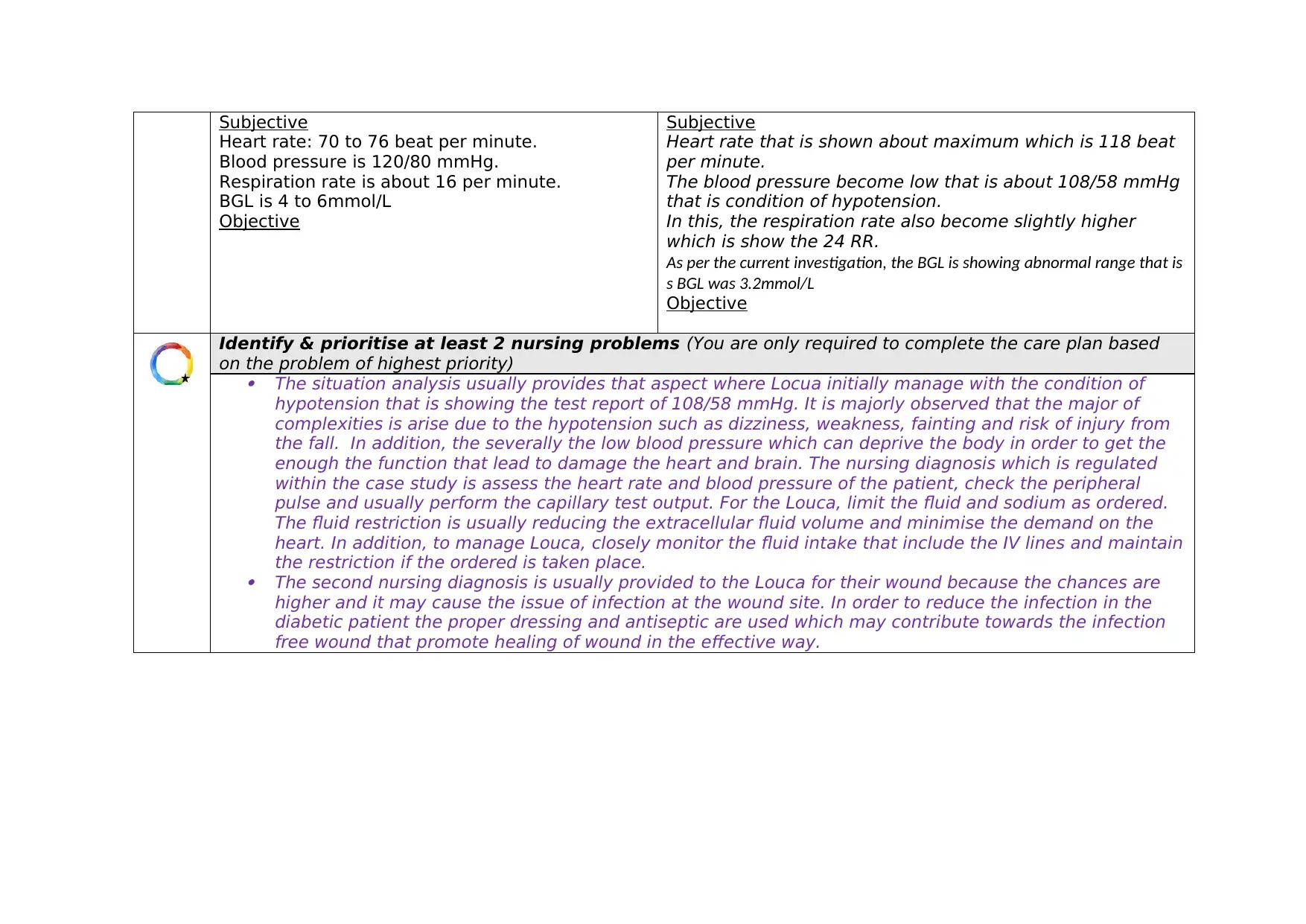
Subjective
Heart rate: 70 to 76 beat per minute.
Blood pressure is 120/80 mmHg.
Respiration rate is about 16 per minute.
BGL is 4 to 6mmol/L
Objective
Subjective
Heart rate that is shown about maximum which is 118 beat
per minute.
The blood pressure become low that is about 108/58 mmHg
that is condition of hypotension.
In this, the respiration rate also become slightly higher
which is show the 24 RR.
As per the current investigation, the BGL is showing abnormal range that is
s BGL was 3.2mmol/L
Objective
Identify & prioritise at least 2 nursing problems (You are only required to complete the care plan based
on the problem of highest priority)
The situation analysis usually provides that aspect where Locua initially manage with the condition of
hypotension that is showing the test report of 108/58 mmHg. It is majorly observed that the major of
complexities is arise due to the hypotension such as dizziness, weakness, fainting and risk of injury from
the fall. In addition, the severally the low blood pressure which can deprive the body in order to get the
enough the function that lead to damage the heart and brain. The nursing diagnosis which is regulated
within the case study is assess the heart rate and blood pressure of the patient, check the peripheral
pulse and usually perform the capillary test output. For the Louca, limit the fluid and sodium as ordered.
The fluid restriction is usually reducing the extracellular fluid volume and minimise the demand on the
heart. In addition, to manage Louca, closely monitor the fluid intake that include the IV lines and maintain
the restriction if the ordered is taken place.
The second nursing diagnosis is usually provided to the Louca for their wound because the chances are
higher and it may cause the issue of infection at the wound site. In order to reduce the infection in the
diabetic patient the proper dressing and antiseptic are used which may contribute towards the infection
free wound that promote healing of wound in the effective way.
Heart rate: 70 to 76 beat per minute.
Blood pressure is 120/80 mmHg.
Respiration rate is about 16 per minute.
BGL is 4 to 6mmol/L
Objective
Subjective
Heart rate that is shown about maximum which is 118 beat
per minute.
The blood pressure become low that is about 108/58 mmHg
that is condition of hypotension.
In this, the respiration rate also become slightly higher
which is show the 24 RR.
As per the current investigation, the BGL is showing abnormal range that is
s BGL was 3.2mmol/L
Objective
Identify & prioritise at least 2 nursing problems (You are only required to complete the care plan based
on the problem of highest priority)
The situation analysis usually provides that aspect where Locua initially manage with the condition of
hypotension that is showing the test report of 108/58 mmHg. It is majorly observed that the major of
complexities is arise due to the hypotension such as dizziness, weakness, fainting and risk of injury from
the fall. In addition, the severally the low blood pressure which can deprive the body in order to get the
enough the function that lead to damage the heart and brain. The nursing diagnosis which is regulated
within the case study is assess the heart rate and blood pressure of the patient, check the peripheral
pulse and usually perform the capillary test output. For the Louca, limit the fluid and sodium as ordered.
The fluid restriction is usually reducing the extracellular fluid volume and minimise the demand on the
heart. In addition, to manage Louca, closely monitor the fluid intake that include the IV lines and maintain
the restriction if the ordered is taken place.
The second nursing diagnosis is usually provided to the Louca for their wound because the chances are
higher and it may cause the issue of infection at the wound site. In order to reduce the infection in the
diabetic patient the proper dressing and antiseptic are used which may contribute towards the infection
free wound that promote healing of wound in the effective way.
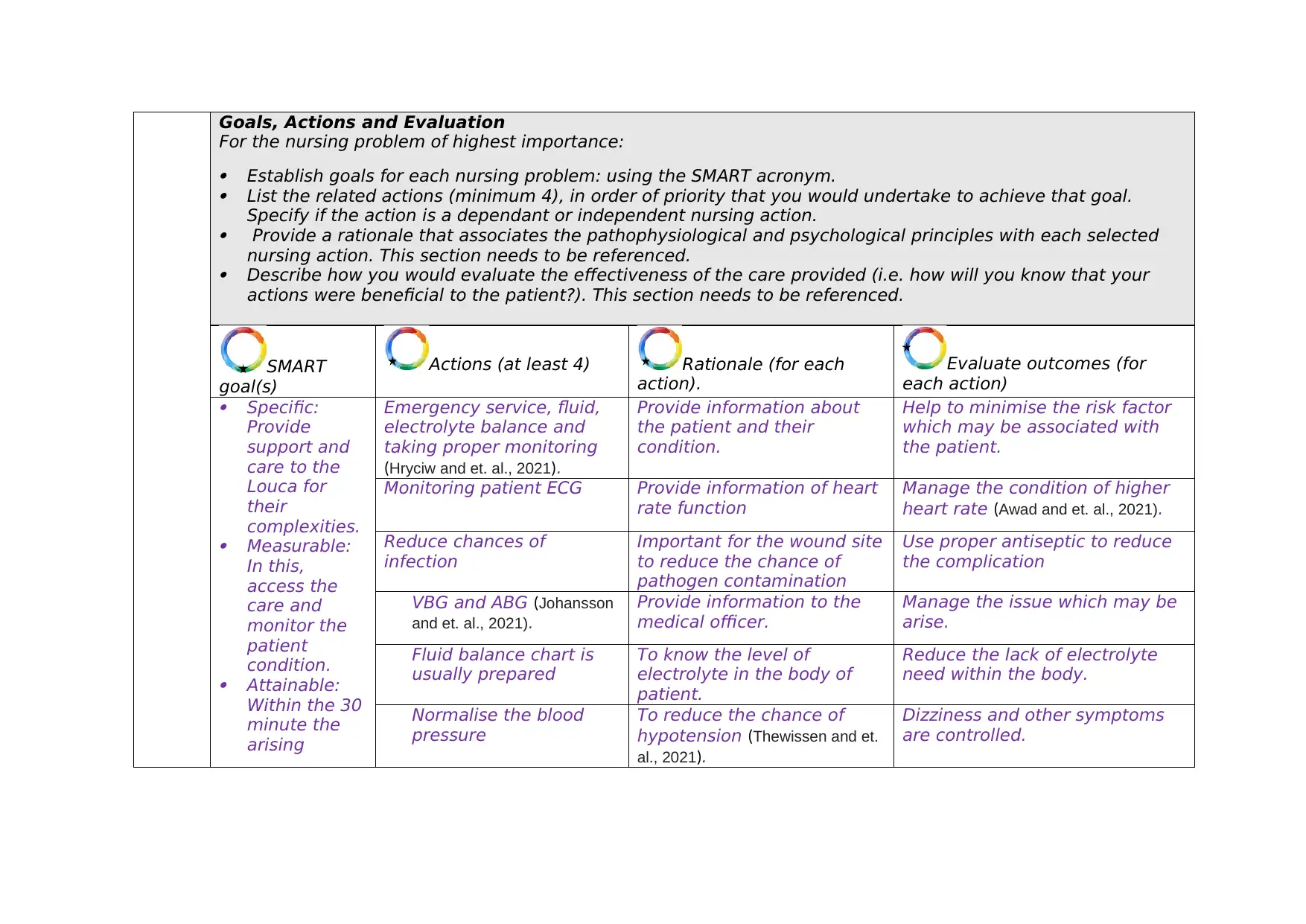
Goals, Actions and Evaluation
For the nursing problem of highest importance:
Establish goals for each nursing problem: using the SMART acronym.
List the related actions (minimum 4), in order of priority that you would undertake to achieve that goal.
Specify if the action is a dependant or independent nursing action.
Provide a rationale that associates the pathophysiological and psychological principles with each selected
nursing action. This section needs to be referenced.
Describe how you would evaluate the effectiveness of the care provided (i.e. how will you know that your
actions were beneficial to the patient?). This section needs to be referenced.
SMART
goal(s)
Actions (at least 4) Rationale (for each
action).
Evaluate outcomes (for
each action)
Specific:
Provide
support and
care to the
Louca for
their
complexities.
Measurable:
In this,
access the
care and
monitor the
patient
condition.
Attainable:
Within the 30
minute the
arising
Emergency service, fluid,
electrolyte balance and
taking proper monitoring
(Hryciw and et. al., 2021).
Provide information about
the patient and their
condition.
Help to minimise the risk factor
which may be associated with
the patient.
Monitoring patient ECG Provide information of heart
rate function
Manage the condition of higher
heart rate (Awad and et. al., 2021).
Reduce chances of
infection
Important for the wound site
to reduce the chance of
pathogen contamination
Use proper antiseptic to reduce
the complication
VBG and ABG (Johansson
and et. al., 2021).
Provide information to the
medical officer.
Manage the issue which may be
arise.
Fluid balance chart is
usually prepared
To know the level of
electrolyte in the body of
patient.
Reduce the lack of electrolyte
need within the body.
Normalise the blood
pressure
To reduce the chance of
hypotension (Thewissen and et.
al., 2021).
Dizziness and other symptoms
are controlled.
For the nursing problem of highest importance:
Establish goals for each nursing problem: using the SMART acronym.
List the related actions (minimum 4), in order of priority that you would undertake to achieve that goal.
Specify if the action is a dependant or independent nursing action.
Provide a rationale that associates the pathophysiological and psychological principles with each selected
nursing action. This section needs to be referenced.
Describe how you would evaluate the effectiveness of the care provided (i.e. how will you know that your
actions were beneficial to the patient?). This section needs to be referenced.
SMART
goal(s)
Actions (at least 4) Rationale (for each
action).
Evaluate outcomes (for
each action)
Specific:
Provide
support and
care to the
Louca for
their
complexities.
Measurable:
In this,
access the
care and
monitor the
patient
condition.
Attainable:
Within the 30
minute the
arising
Emergency service, fluid,
electrolyte balance and
taking proper monitoring
(Hryciw and et. al., 2021).
Provide information about
the patient and their
condition.
Help to minimise the risk factor
which may be associated with
the patient.
Monitoring patient ECG Provide information of heart
rate function
Manage the condition of higher
heart rate (Awad and et. al., 2021).
Reduce chances of
infection
Important for the wound site
to reduce the chance of
pathogen contamination
Use proper antiseptic to reduce
the complication
VBG and ABG (Johansson
and et. al., 2021).
Provide information to the
medical officer.
Manage the issue which may be
arise.
Fluid balance chart is
usually prepared
To know the level of
electrolyte in the body of
patient.
Reduce the lack of electrolyte
need within the body.
Normalise the blood
pressure
To reduce the chance of
hypotension (Thewissen and et.
al., 2021).
Dizziness and other symptoms
are controlled.
⊘ This is a preview!⊘
Do you want full access?
Subscribe today to unlock all pages.

Trusted by 1+ million students worldwide
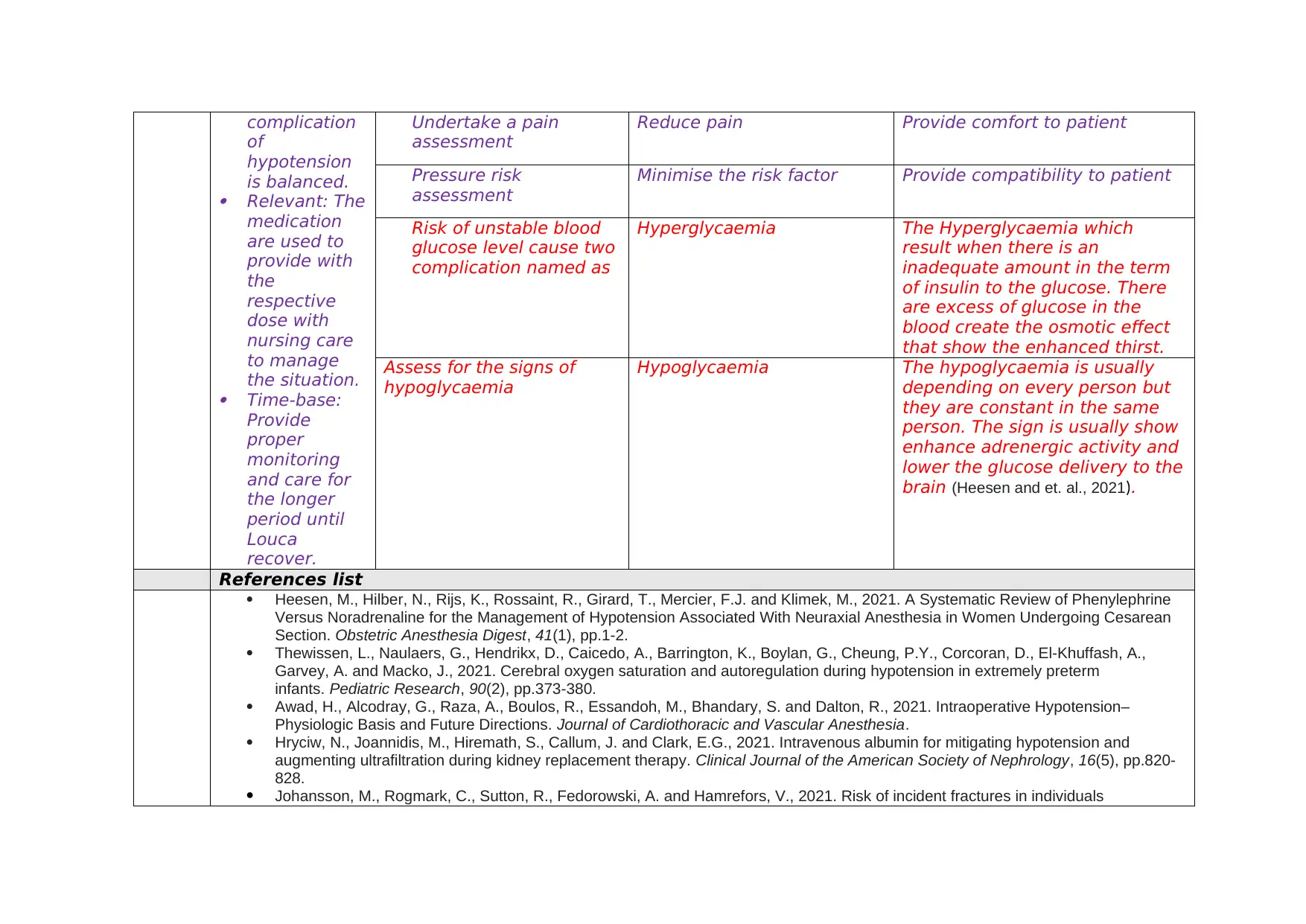
complication
of
hypotension
is balanced.
Relevant: The
medication
are used to
provide with
the
respective
dose with
nursing care
to manage
the situation.
Time-base:
Provide
proper
monitoring
and care for
the longer
period until
Louca
recover.
Undertake a pain
assessment
Reduce pain Provide comfort to patient
Pressure risk
assessment
Minimise the risk factor Provide compatibility to patient
Risk of unstable blood
glucose level cause two
complication named as
Hyperglycaemia The Hyperglycaemia which
result when there is an
inadequate amount in the term
of insulin to the glucose. There
are excess of glucose in the
blood create the osmotic effect
that show the enhanced thirst.
Assess for the signs of
hypoglycaemia
Hypoglycaemia The hypoglycaemia is usually
depending on every person but
they are constant in the same
person. The sign is usually show
enhance adrenergic activity and
lower the glucose delivery to the
brain (Heesen and et. al., 2021).
References list
Heesen, M., Hilber, N., Rijs, K., Rossaint, R., Girard, T., Mercier, F.J. and Klimek, M., 2021. A Systematic Review of Phenylephrine
Versus Noradrenaline for the Management of Hypotension Associated With Neuraxial Anesthesia in Women Undergoing Cesarean
Section. Obstetric Anesthesia Digest, 41(1), pp.1-2.
Thewissen, L., Naulaers, G., Hendrikx, D., Caicedo, A., Barrington, K., Boylan, G., Cheung, P.Y., Corcoran, D., El-Khuffash, A.,
Garvey, A. and Macko, J., 2021. Cerebral oxygen saturation and autoregulation during hypotension in extremely preterm
infants. Pediatric Research, 90(2), pp.373-380.
Awad, H., Alcodray, G., Raza, A., Boulos, R., Essandoh, M., Bhandary, S. and Dalton, R., 2021. Intraoperative Hypotension–
Physiologic Basis and Future Directions. Journal of Cardiothoracic and Vascular Anesthesia.
Hryciw, N., Joannidis, M., Hiremath, S., Callum, J. and Clark, E.G., 2021. Intravenous albumin for mitigating hypotension and
augmenting ultrafiltration during kidney replacement therapy. Clinical Journal of the American Society of Nephrology, 16(5), pp.820-
828.
Johansson, M., Rogmark, C., Sutton, R., Fedorowski, A. and Hamrefors, V., 2021. Risk of incident fractures in individuals
of
hypotension
is balanced.
Relevant: The
medication
are used to
provide with
the
respective
dose with
nursing care
to manage
the situation.
Time-base:
Provide
proper
monitoring
and care for
the longer
period until
Louca
recover.
Undertake a pain
assessment
Reduce pain Provide comfort to patient
Pressure risk
assessment
Minimise the risk factor Provide compatibility to patient
Risk of unstable blood
glucose level cause two
complication named as
Hyperglycaemia The Hyperglycaemia which
result when there is an
inadequate amount in the term
of insulin to the glucose. There
are excess of glucose in the
blood create the osmotic effect
that show the enhanced thirst.
Assess for the signs of
hypoglycaemia
Hypoglycaemia The hypoglycaemia is usually
depending on every person but
they are constant in the same
person. The sign is usually show
enhance adrenergic activity and
lower the glucose delivery to the
brain (Heesen and et. al., 2021).
References list
Heesen, M., Hilber, N., Rijs, K., Rossaint, R., Girard, T., Mercier, F.J. and Klimek, M., 2021. A Systematic Review of Phenylephrine
Versus Noradrenaline for the Management of Hypotension Associated With Neuraxial Anesthesia in Women Undergoing Cesarean
Section. Obstetric Anesthesia Digest, 41(1), pp.1-2.
Thewissen, L., Naulaers, G., Hendrikx, D., Caicedo, A., Barrington, K., Boylan, G., Cheung, P.Y., Corcoran, D., El-Khuffash, A.,
Garvey, A. and Macko, J., 2021. Cerebral oxygen saturation and autoregulation during hypotension in extremely preterm
infants. Pediatric Research, 90(2), pp.373-380.
Awad, H., Alcodray, G., Raza, A., Boulos, R., Essandoh, M., Bhandary, S. and Dalton, R., 2021. Intraoperative Hypotension–
Physiologic Basis and Future Directions. Journal of Cardiothoracic and Vascular Anesthesia.
Hryciw, N., Joannidis, M., Hiremath, S., Callum, J. and Clark, E.G., 2021. Intravenous albumin for mitigating hypotension and
augmenting ultrafiltration during kidney replacement therapy. Clinical Journal of the American Society of Nephrology, 16(5), pp.820-
828.
Johansson, M., Rogmark, C., Sutton, R., Fedorowski, A. and Hamrefors, V., 2021. Risk of incident fractures in individuals
Paraphrase This Document
Need a fresh take? Get an instant paraphrase of this document with our AI Paraphraser
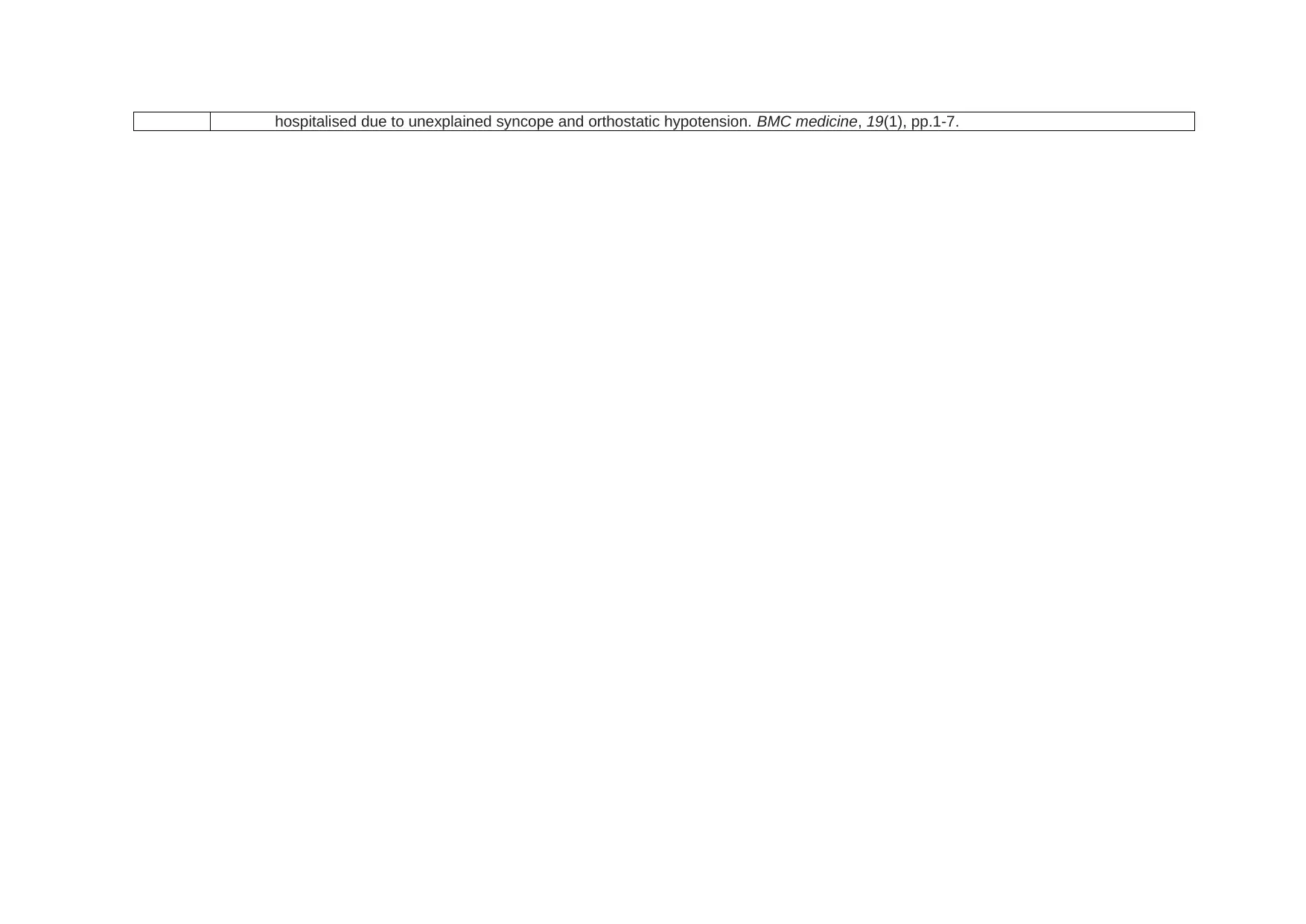
hospitalised due to unexplained syncope and orthostatic hypotension. BMC medicine, 19(1), pp.1-7.
1 out of 5
Related Documents
Your All-in-One AI-Powered Toolkit for Academic Success.
+13062052269
info@desklib.com
Available 24*7 on WhatsApp / Email
![[object Object]](/_next/static/media/star-bottom.7253800d.svg)
Unlock your academic potential
Copyright © 2020–2025 A2Z Services. All Rights Reserved. Developed and managed by ZUCOL.





